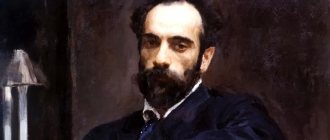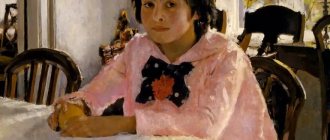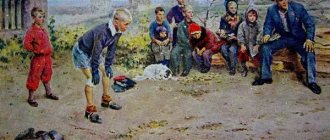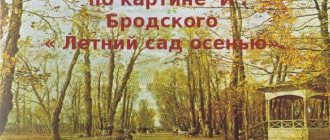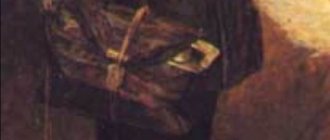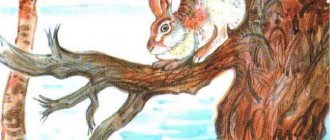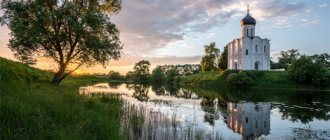Isaac Ilyich Levitan is a talented Russian artist. He is considered the outstanding founder of landscape painting of the 19th century, a spiritual master who creates a poetic image of nature. His paintings are filled with warm, soft tones. Simple images of Russian nature bring peace, tranquility and quiet joy of contemplation. Levitan's paintings are landscapes of mood with surprisingly truthful authenticity. During his creative biography, Levitan created thousands of paintings and sketches.
“Evening Bells” is a landscape by Isaac Levitan, painted in 1892. The painting belongs to the State Tretyakov Gallery.
Let's look at the picture in detail and answer the questions.
Questions about the painting “Evening Bells”
- What is evening bell? Evening ringing is the beginning of the evening service, and the Orthodox daily cycle of worship begins with it.
- What impression did the picture make on you? What did you like?
- What time of year is shown in the picture? What time of day? What does this indicate? Warm summer evening. The sun had already dropped behind the forest, casting its last rays over the horizon and illuminating the monastery and the forest.
- What else did the artist depict? A ferry floats along the river, carrying people to the other side. Monastery surrounded by autumn forest. The temple is located at the bend of a deep, calm river. High pre-sunset sky, clear and brightly reflected in the river. The horizon is closed by an oak forest. People sailing to the temple for evening prayer.
- Describe the monastery. What place does he occupy in the picture? A wide road leads to the monastery; pilgrims walk along it. Gate in the form of an arch. The monastery is illuminated by the last rays of the sun. A bell tower rises above the forest. The artist depicted the monastery in the center of the picture.
- What do you see in the foreground? In the central part? On the background?
- The painting is called “Evening Bells”. Is it possible to depict sound on canvas? Let's get into the picture. What sounds do we hear? The ringing of bells, the music of the wind, the singing of birds, the rustling of leaves, the sound of the river). (It’s a windless evening: the flowers, grass, leaves on the trees are motionless, the clouds are almost motionless, there are light ripples along the river from the ferry. Water is always sounds.
- How does the artist express his attitude towards what he sees? With the help of colors - warm, gentle; shades of green, yellow, brown, pinkish-lilac. The picture is transparent. Paints are not only color, they are the basis for expressing mood, state, feeling. Only in color can you feel how shadows fall on the ground, how transparent and calm the river is.
- Why is the painting called “Evening Bells”? Let's go back to the picture that we will hear: the evening ringing combines the ringing of bells, the sounds of nature, and the magical music of the artist's soul.
- How do you feel when you hear a bell ringing? When the bells ring, a feeling of solemnity, grandeur, and grace arises in the soul.
- What mood does this picture evoke? When I look at the picture, I have a feeling of calm, peace, expectation of something bright, kind, good.
Description of the painting “Evening Bells” by Levitan
In front of the viewer is a wide river, the calm waters of which reflect sparse feather clouds, colored by the setting sun in pink and golden shades. The summer day is coming to an end. In the quiet hours before sunset, people rush to finish their business: a man at the crossing on the near bank in a boat, people on a ferry in the center of the river, hurrying to the evening service, two monks meeting them. On the opposite bank, overgrown with forest, there is a monastery. The snow-white walls of his temple and bell tower are brightly illuminated by the last rays of the generous summer sun, making them appear golden. Their reflection in the mirror surface of the river makes the emphasis on the temple buildings even brighter. The far bank beyond the bend is also surrounded by dense forests. There is peace and tranquility throughout.
Plan for a descriptive essay based on the painting “Evening Bells” by Levitan
1. Introduction: Before us is a painting by a wonderful artist_____ (indicate the full name of the artist and the name of the painting) During a literary reading lesson, we met the magnificent painting ___________ (indicate the full name of the artist and the name of the painting) The painting (it) was painted in the genre _______( indicate the genre) 2. Main part: In the foreground of the painting: In the foreground of the painting we see_____(what?) The journey into the world of the painting begins with _______(what?) In the foreground of the painting, the artist depicted _____(what?) In the foreground, the artist highlighted_____ (what?) (in some color (specify) and/or composition). Directly in front of us are _____(who/what?) In the center of the picture: In the center of the picture we see _____(who/what?)__________what? In front of us are depicted ______(who/what?)_______________which In the background: In the background of the picture is located (use the desired shape) _______(what?/who?) The background is occupied by_____(what?) In the distance opens_____(what?) Color scheme: Depicting ____(what?) The artist uses a huge range of colors and shades. (Next, describe in detail the color scheme of the painting) The colors in the painting are amazing: ____ (list) ______ (what?) colors predominate in the painting. This makes the picture____(what?) 3. Conclusion What mood, emotions does this picture evoke in you? When I look at the painting ____ (whose? + title), I remember ____ (what?) Admiring the painting, I felt ____ (what?) The painting creates ____ (what?) mood. This canvas smells of _____(what?) The artist managed to brilliantly convey ____mood.
Impressions from the painting and its fate
“Evening Bells” is considered by art critics to be one of Levitan’s most meaningful and philosophical paintings. Inspired by it, poets compose poems, composers write music, thousands of people think and dream. After all, the overall atmosphere of the picture, extremely kind-hearted, evokes feelings like after a confession: peace and tranquility come to replace mental anxiety.
After the first exhibition, the painting was acquired by the noble noble family of the Ratkov-Rozhnovs. Only after the revolution, when the family emigrated to Europe, Levitan’s masterpiece “Evening Bells” was transferred to the Tretyakov Gallery.
Essay based on the painting “Evening Bells” by Isaac Levitan, grade 3
In front of me is a painting by the great Russian artist Isaac Levitan “Evening Bells”. Warm summer evening. But the sun has not yet hidden. It illuminates the white walls of the church and the autumn forest. In the foreground there is a shore and two boats. Another boat with people swam to the middle of the river. Believers rush to the evening service at the temple. On the other side, monks are waiting for them. There is a wide road from the river to the temple. The blue sky and dark blue river seemed to envelop the white monastery in their tranquility. The clear, calm water reflects curly pinkish clouds and a white temple with golden domes. In the background you can see a church with numerous bell towers. All buildings are surrounded by dark green trees. But yellow bushes are already visible. The sun's rays give the trees an autumn glow. The sound of bells gathers everyone for evening prayer. The painting exudes calm and grandeur.
***
The painting “Evening Bells” was painted by the famous artist I. Levitan in the 19th century. The landscape depicts evening, the sun is already setting behind the horizon. It casts its rays on the forest, temple and river. The dark blue river takes up almost half of the picture. It is quiet and calm, and the entire distant shore is reflected in it, like in a mirror. A boat with people is floating in the middle of the river. In the foreground we see the shore, two boats are rocking at the pier. In one there is a fisherman. The shore is dotted with wildflowers that emerge from the faded autumn grass. On the other bank are the white buildings of the monastery, which are surrounded by mixed forest and bushes. The domes of the temples are cast in gold, playing with the sun's rays. The author used warm colors to paint the picture. Even the blue sky is decorated with pinkish light clouds. The landscape is magnificent! It feels cool and quiet. I want to sit in a boat, listen to the sounds of bells, birdsong, and take a break from the bustle of the world.
Essay based on the painting “Evening Bells” by Isaac Levitan
A warm summer evening, a picturesque river, several boats on the shore, shiny golden bell towers on the horizon, a mesmerizingly beautiful sky - all this is depicted in the painting “Evening Ringing” by Isaac Ilyich Levitan. Students in grades 4 and 8 are asked to write an essay on the topic every year.
Brief biography of the artist
The famous Russian painter Isaac Ilyich Levitan was born in 1860 in the small town of Kibartai in Lithuania. His father was a small clerk. A few years after the birth of their son, the family moved to Moscow , as the parents really wanted to give their children a decent education.
At the age of 13, Isaac became a student at the capital's school of painting and architecture. His teachers were Alexey Savrasov and Vasily Polenov. The teachers immediately noticed the talent in the young man. Some time later, the mother suddenly died, then the father fell ill and died. The boy was forced to skip school in order to work and provide for his livelihood.
Despite all the difficulties, Isaac Levitan studied well, but the young man never became a certified artist. Most likely, this happened because of the guy’s Jewish roots. Instead, he was awarded a diploma as a teacher of calligraphy.
In 1890, Levitan painted a picture that later made him famous. The work was called “Quiet Abode”. She appeared before the audience in 1891 during an exhibition.
The painting immediately attracted the attention of not only ordinary people, but also connoisseurs of great art. The artist Benoit was amazed by Levitan’s talent, describing his creation “like a breath of fresh air.”
An important aspect: the history of writing “The Quiet Abode” is closely intertwined with “Evening Bells,” which was created in 1892. The works were not at all a “portrait” of a specific area. This is the artist’s fantasy, inspired by the images of several monasteries. Some of them:
For his work, Isaac Ilyich used the name of the popular composition “Evening Bells.” It is no coincidence that art critic Alexey Alexandrovich Fedorov-Davydov called Levitan’s painting the artist’s most philosophical and literary work.
Description of the picture
It is impossible to convey all the beauty of the author’s work in a few words. In the process of describing Levitan’s painting “Evening Bells”, it should be noted that it was made on canvas using the oil technique . The size of the image is 87 by 108 cm. The artist was an adherent of the style of realism.
If you write a very short essay on Levitan’s painting “Evening Bells,” you can say that the landscape is typical for central Russia. The artist captured the image looking from the shore. In the foreground you can see a piece of land covered with grass.
The basis of the picture is a grove in autumn decoration with yellow-green shades . A monastery is visible in the distance. The difference between “The Quiet Abode” and “Evening Bells” is that in the first case the banks of the river are connected by a dilapidated bridge, while in the second the connecting link is boats.
However, in the foreground there are still wooden bridges adjacent to the shore. Most likely, they are used as a pier from which women wash their clothes in the river. However, there are no boats near them: they are standing near the shore.
A lonely man sits in the same boat. Another ship full of people is moving along the river. On the opposite bank there is a wide road along the slope to a white gate in the form of arches. Two miniature figures can be seen near the water. Perhaps they are monks. On the right side of the gate there is a white five-domed monastery with green domes.
Surviving photos of the Krivoozersky Church indicate that it was he who became the prototype for the monastery in Levitan’s painting . On the left side of the gate, between the trees, there is a one-domed church. The white bell tower rises above a low building with a small dome. The walls of the building are snow-white, the roof is green.
Most of the canvas is occupied by sky and water. The river cuts through the land, carefully skirting the coastline. The water surface reflects the outlines of temples, as well as thickets near the shore. Levitan did not just depict churches against the backdrop of a beautiful landscape. He brought a sense of peace to the painting. Looking at it, it seems that you can hear a subtle bell ringing.
Isaac Levitan is a talented artist, author of many famous paintings. “Evening Bells” is one of his first works. On it the painter depicted an incredibly beautiful landscape. Two churches located in the distance harmoniously complemented his work.
Essay based on the painting “Evening Bells” by Isaac Levitan, grade 4
***
Landscape artist Isaac Levitan introduces us to his work “Evening Bells”. The journey into the world of this picture begins with a view of the river and sky. Most of the canvas is occupied by a calm river. The weather is calm, and in the still surface of the water you can see the reflection of a snow-white temple with golden domes and an autumn forest. A boat is sailing to the far shore. The people sitting in it are silent, thinking their thoughts. Smoothly floating clouds also froze over the church, listening to the overflow of bells, birdsong and splashes of water from the oars. In the foreground of the painting, the artist depicted the shore. Gray sand and already withered green grass give the picture special meaning. Everyone is waiting for autumn and cold. There are two boats moored near the shore. A man sits in one. Perhaps it's a fisherman. In the center of the picture we see a white monastery and a forest. Depicting nature, I. Levitan used a huge range of colors and shades. From the soft pink sky and the gray-blue river the artist smoothly moves to the image of a golden forest and bright bushes. Green color in several shades is visible along the banks of the river. And only the buildings of the monastery remain light even in the evening, shimmering in the rays of the setting sun. I liked the picture! The artist managed to brilliantly convey the mood of calm, silence, and melody. The sounds of nature and bells are intertwined into one.
Characters in the picture
The misconception that the faces and figures of people were not given to the artist is based on certain facts:
- In the huge creative heritage of Isaac Levitan, which, together with sketches, amounts to thousands of paintings, there are only about ten portrait works;
- Female figure in the landscape “Autumn Day. Sokolniki” was made by Nikolai Chekhov, Levitan’s classmate and brother of the writer Anton Pavlovich, with whom Isaac Ilyich was friends all his life;
- Viewers were convinced that Levitan's landscapes were self-sufficient: the artist avoided incorporating humans into a pure natural landscape.
But in fact, the painter, during and after his studies (he studied for 11 years), had significant success, working in different directions: creating theatrical scenery, illustrating books and magazines, including graphics, painting portraits and still lifes. So Levitan’s depiction of human figures can be characterized as an unloved activity. According to the memoirs of Konstantin Korovin, his argument with Levitan over the need for an artist to study anatomy ended with Isaac’s conclusion: “I want to paint a haystack, but it has no bones or anatomy.”
Levitan still added several figures to the painting “Evening Bells,” albeit very blurry and sketchy. They help to “hear” the ringing of bells.

